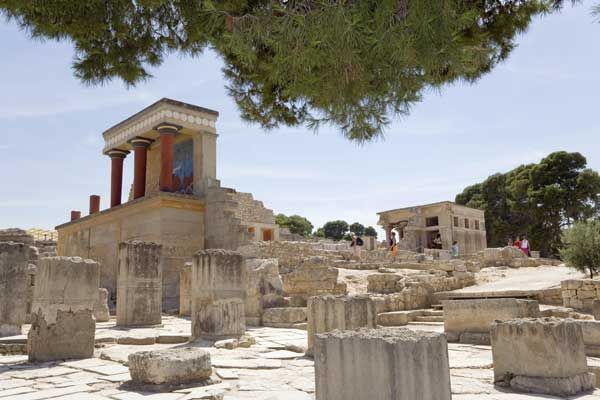To discover Crete is to discover the foundations of our civilisation: the island is like a dream that has been dreamed down through the centuries and that promises to continue for centuries to come. The best way to discover the hidden treasures is starting with the capital, the cosmopolitan city of Heraklion. Here, in the ancient metropolis, the blend of history and legend, the traditional and the modern, is mapped out between centuries-old Byzantine churches and modern buildings overlooking the sea. One of the gems of Heraklion is its archaeological museum, and a visit is essential for a better understanding of the island's rich history.
The museum houses most of the treasures of the Minoan civilisation unearthed at Phaistos, Malia and Knossos, the most famous of all island's archaeological sites, which was excavated in the early twentieth century by British archaeologist Sir Arthur Evans. Many details of the Minoan culture may remain uncertain, but the colossal ruins stand clear and perfect for exploration. This is the site of one of the most popular legends of all time: the story of the minotaur - the monstrous creature, half man, half bull who lived in the labyrinth - and how he was killed by Theseus, prince of Athens, with the help of Ariadne.
Heading around the island in a clockwise direction, east of the capital lies the small coastal town of Agios Nikolaus, popular with tourists wanting to disconnect. In the centre of the town is the Voulismeni lagoon, which local legend says is bottomless. Beyond, lies the lively little port of Sitia, and some 20 kilometres farther on, on the north eastern tip of the island is Vai Beach, site of the largest natural palm forest in Europe.
To the south, the roads twist and wind, but the scenery makes the drive well worth it. All across the island there are marvellous Byzantine churches and monasteries, and on a hill top, looking out over the south coast, the ruins of Phaistos still speak of the glorious classical past. Farther to the west lies the White Mountains National Park, home to over 450 species of plants and animals, as well as one of the island's greatest natural treasures: the impressive Samaria Gorge, a steep, narrow canyon, that varies in width from 150 to just three metres and offers great hiking and walking opportunities.
THE PRACTICALITIES
Getting there From the UK, EasyJet fly direct to Heraklion from Gatwick, Manchester and Bristol and to Chania from Gatwick. Alternately, you could fly to Athens and then on to Crete with Aegean Airlines or take the six-hour boat trip from the port of Piraeus with Minoan Lines.
Getting around The best option is to rent a car, although it can be fun to do some exploring by bike, or even by donkey.
Where to stay The luxurious Galaxy Iraklio in Heraklion has welcomed heads of state, royals and all kinds of celebrities on their visits to the island. Also in Heraklion, the elegant and sophisticated Lato Boutique, with its avant-garde decor and superb views over the sea. Just over 20 kilometres from Heraklion, on the north coast of the island, is the spectacular five-star Amirandes resort. The same degree of luxury and comfort is offered at the Minos Imperial, a stunning resort in the quiet setting of Milatos.
Where to eat The sophisticated restaurant Avli in Rethymon, is located in a sixteenth-century Venetian-style villa; considered the best on the island with its creative interpretation of the typical local dishes, it is the ideal place to sample Greek wine as its wine list boasts around 400 types. In Heraklion, the Brillant Gourmet restaurant, whose chef Kosmadaquis Petros is one of the most famous in Greece, offers exquisite and refined Mediterranean cuisine in an avant-garde atmosphere. For more information on Crete restaurants visit the Meet and Eat in Crete website.
Don't miss Elafonissi, a small uninhabited island about 100 metres off the southwestern tip of the island. In fine weather when the sea is calm, you can swim or walk across to this marvellous protected nature reserve which boasts beautiful beaches and warm shallow waters for bathing. Another perfect islet to get away from it all is Spinalonga (also known as Kalydon), reached from Plaka on the north coast, and famed for its pebble beaches.










